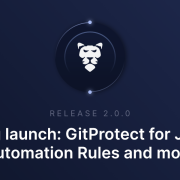
Automate DevOps – Tasks DevOps Should Automate
DevOps is a popular approach to software development that strives to promote communication between development and operations teams, while also expediting the release process through automation in devops. Automating tasks is essential to DevOps since it enhances efficiency and decreases manual errors.
Automation tools can be applied to many areas of the software release lifecycle, from continuous integration and deployment to monitoring and logging, within the context of the DevOps lifecycle. In this post, we’ll examine some of the most critical tasks for DevOps to automate and their benefits.
What will we talk about?
We’ll also review some of the most popular DevOps automation tools. Understanding which DevOps processes should be automated and which solutions are available can help companies improve their DevOps strategies and achieve their software development goals more efficiently.
We will cover the key areas where manual tasks can be reduced, as well as the various solutions available to streamline operations, boost cooperation, and increase speed and efficiency within your organization.
What is DevOps Automation?
Definition and Core Components
DevOps automation is the practice of leveraging technology to streamline and optimize the software development and delivery lifecycle.
It involves automating repetitive tasks and processes to enhance efficiency, reduce human errors, and accelerate time-to-market. The core components of DevOps automation include technology, processes, and feedback loops.
Technology encompasses the tools and platforms that enable automation efforts, such as continuous integration/continuous delivery (CI/CD) platforms and container orchestration tools.
These technologies facilitate the seamless integration and deployment of code, ensuring that software is always in a releasable state.
Processes involve defining and implementing automation workflows, including infrastructure provisioning, deployment, and management. By automating these processes, teams can ensure consistency and reliability across different environments.
Feedback loops are essential for continuous improvement and optimization of automation processes. They provide valuable insights into the performance and effectiveness of automated workflows, allowing teams to make data-driven decisions and refine their strategies.
Overall, DevOps automation enables teams to focus on higher-value activities, such as innovation and improving software quality, by automating repetitive tasks and processes.
Benefits of DevOps Automation
DevOps automation offers several benefits that significantly enhance the software development process. One of the primary advantages is increased efficiency.
By automating routine tasks and repetitive activities, development teams can save time and resources, allowing them to focus on more strategic activities. This leads to faster deployment and a shorter time-to-market, giving organizations a competitive edge.
Another key benefit is the reduction of human errors. Manual processes are prone to human error, leading to costly mistakes and downtime. DevOps automation minimizes these risks, including through automated security testing, by ensuring consistency and accuracy in every step of the software development lifecycle, resulting in improved software quality and reliability.
DevOps automation capabilities also promote better collaboration and communication between development and operations teams, along with quality assurance teams. By automating processes, teams can work together more effectively, breaking down silos and fostering a culture of shared responsibility.
This collaborative approach leads to more efficient problem-solving and faster issue resolution. Additionally, DevOps automation enables organizations to scale their operations more efficiently.
Automated processes can handle increased workloads without compromising performance, allowing businesses to grow and adapt to changing demands.
Overall, DevOps automation is a powerful tool that drives efficiency, reduces errors, and accelerates the software delivery lifecycle.
DevOps Automation Tools in DevOps Practices
Automation is critical in DevOps approaches, as it streamlines development and operations processes, including infrastructure as code, creating efficient workflows and high-quality software releases.
This method can be used in various areas, including continuous integration and continuous deployment (CI/CD), backup and security, and configuration management.
CI/CD automation
Continuous integration and continuous deployment (CI/CD) relate to automating software development, automated tests, and deployment.
By automating these procedures, teams can detect and address issues faster, as well as release new software versions more often.
This method assures that software is always accessible, removing the potential for high risk and downtime. It also implies that new software versions are released regularly and efficiently.
Below, we mentioned the main reasons for improving CI/CD manual tasks:
- It reduces the possibility of mistakes. Teams can find and repair defects faster by automating the development, functional testing, and deployment processes, lowering the risk of mistakes and downtime.
- It aids in increasing productivity. It can also aid in the improvement of overall program performance and security.
- It fosters better collaboration between operational and development teams. Groups may collaborate more efficiently by automating the development, testing, and deployment processes. They can rely on automation to keep software in a releasable state at any time.
Organizations may utilize a variety of popular CI/CD automation tools, such as Jenkins or CircleCI, which we will discuss later in the article.
Backup and security automation
The practice of automating code and metadata security through the use of scripts and tools is known as backup and security automation. This method enhances the capacity to quickly restore metadata and software in the event of a disaster.
By automating this crucial element, developers can ensure that the project meets industry standards and legal requirements. This also simplifies carrying out required audits.
The main benefits of automatic backup and security are reduced data loss and downtime. Additionally, it can help increase the security of applications and infrastructure as a whole.
You may utilize third-party backup tools, like GitProtect.io, for this step.
Configuration management automation
Configuration management automation is the process of automating the management of software configurations using tools and scripts.
Such a method ensures that the program is delivered uniformly across all environments and that configuration changes can be traced and inspected.
By automating the configuration management process, teams can guarantee that software is deployed consistently across all environments. This can help decrease the likelihood of mistakes and downtime while also improving overall program performance and security.
It also promotes better communication between development and operational teams, making it easier for diverse teams to collaborate and exchange information.
Companies can employ various popular configuration management automation technologies, such as Ansible. This tool enables teams to automate resource deployment and scaling, as well as track and audit configuration changes.
Automated Testing and Quality Assurance
Automated Unit Testing
Automated unit testing is a critical component of DevOps automation. It involves automating the execution of unit tests, which are designed to test individual components or units of code.
By automating these tests and using comprehensive test suites, developers can detect and fix issues early in the development cycle, reducing the risk of downstream problems.
Automated unit testing enables teams to test code more frequently, reducing the time and effort required to identify and fix defects.
Continuous integration, continuous delivery
Automated unit testing is typically performed using automated testing tools, such as JUnit or TestNG, which can be integrated into the CI/CD pipeline. These tools allow developers to run tests automatically whenever code changes are made, ensuring that any issues are identified and addressed promptly.
The continuous testing helps maintain high code quality and prevents defects from accumulating.
The benefits of automated unit testing are numerous. It improves code quality by ensuring that each component functions correctly before it is integrated into the larger system. This reduces the likelihood of defects and enhances the overall reliability of the software.
Automated unit testing also reduces testing time, allowing developers to focus on writing code rather than manually testing individual components. This increased productivity leads to faster development cycles and quicker releases.
Other types of testing
In addition to automated unit testing, DevOps automation enables teams to automate other types of testing, such as integration testing, system reliability testing, and acceptance testing. These types of testing can be automated using a variety of tools and techniques, including automated testing frameworks like Selenium or Appium, and test automation platforms like TestComplete or Ranorex.
By implementing automated testing processes, teams can ensure comprehensive test coverage and maintain high software quality throughout the development lifecycle.
Overall, DevOps automation is a critical component of modern software dev, enabling teams to deliver high-quality software faster and more efficiently. By automating tasks and DevOps processes, teams can focus on higher-value activities, such as writing code and improving software quality.
DevOps automation tools
DevOps automation technologies are critical for optimizing operations and delivering high-quality software releases. Jenkins, Ansible, Terraform, and Kubernetes are some popular tools that your company may adopt to automate its DevOps.
- Jenkins, which is an open-source continuous integration and continuous deployment (CI/CD) automation tool.
- Ansible, which is a free-to-use configuration management solution.
- Terraform, which is an open-source infrastructure as code automation tool.
- Kubernetes, which is a container orchestration solution that is open source, and used for container management and deployment.
GitProtect.io – backup and security automation tool
GitProtect.io is a cloud-based platform that assists teams in automating the backup and security of Git repositories. It operates smoothly with major Git hosting systems like GitHub, GitLab, Azure DevOps and Bitbucket, allowing teams to back up their source code and data simply and securely.
Its automated and continuous backup function allows DevOps teams to plan frequent backups of their repositories. This solution helps to secure the company’s entire source code and data against potential data loss or corruption. It also enables teams to configure several retention rules to preserve backups for varying lengths of time.
The backup software also includes several security tools to help prevent unwanted access and data breaches. Encryption, access restrictions, and audit logging are examples of such features. The application also has an easy-to-use interface for managing, restoring, and downloading backups. It supports various storage and allows for incremental backups.
Why is GitProtect.io a beneficial solution for Git teams? It automates the backup and security of the code and data. It is a crucial complement to the DevOps toolchain since it provides automated and continuous backups, security features, an intuitive interface, and interaction with platforms.
Summary – DevOps automation solution
Automation of DevOps is a critical component of creating efficient workflows and high-quality software deliveries. By automating processes like continuous integration and deployment, configuration management, continuous monitoring, and logging, teams may enhance communication, boost speed and efficiency, and minimize the risk of mistakes.
Jenkins, Ansible, and GitProtect.io are popular DevOps automation technologies. These tools offer various capabilities to assist teams in managing their DevOps operations and achieving their software development goals more quickly.
Understanding which processes should be automated and which technologies are available is critical for organizations trying to enhance their DevOps practices and remain competitive in today’s fast-paced software development industry.
[FREE TRIAL] Ensure compliant DevOps backup and recovery with a 14-day trial 🚀
[CUSTOM DEMO] Let’s talk about how backup & DR software for DevOps can help you mitigate the risks
The article was originally published on February 1st, 2023






